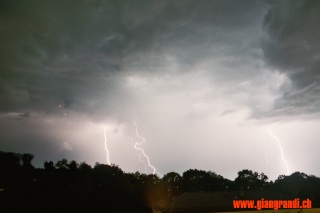
20 mm, f/2.8, 30 s
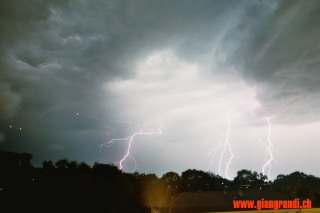
20 mm, f/2.8, 60 s
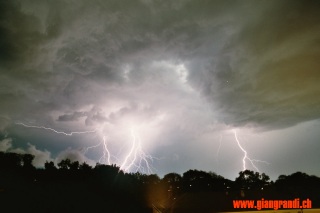
20 mm, f/2.8, 30 s
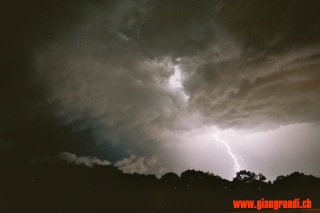
20 mm, f/2.8, 5 s
Storms at night are very nice photographic opportunities and usually give good results with long exposures. Unlike fireworks, they can hardly be predicted and is difficult to find a suitable location and prepare all your equipment in such a short time. Since I'm lazy, I only shoot when I have a nice storm in sight of my window...
Here, I'm talking about shooting lightning strikes at night. During the day, it's very difficult to do long exposures, and I'm not sure if it's possible to take any picture at all.
As usual for long exposures, you need a SLR camera (single lens reflex), a tripod and a remote shutter control. The majority of compact cameras won't work.
A few other accessories are very handy, such a pocket flashlight to set up all your stuff in the dark and help you find things you may loose; a weatherproof jacket, of course, and some plastic bags to protect your photo equipment. Storms can be dangerous, so be careful and respect common sense rules like avoiding exposed places (like hill tops) or under a single tree, don't use an umbrella,...
The best shots are taken from a close distance from the storm centre, right before the rain starts. As soon as you see the first drops falling, you can take your photo equipment to a safe place: the best shots are over. If you're in the middle of a storm, strikes will happen all around you and it will very difficult to aim your camera.
If you're not as lazy as me and don't want to wait that a storm happens in front of your window, you'll have to quickly select a good location and move fast: good shooting opportunities only last ten minutes or so. A zoom lens is usually a good choice: changing the lens in the field is a bad idea because of the strong wind that may blow dust and water inside your camera. If your camera has enough resolution you may still try a wide angle lens and than crop the images afterwards.
With your camera installed on a steady tripod and connected to a remote shutter you have to aim to a location you think the next strike will happen. Of course, you can predict neither the location nor the size of the next strike, but you can guess that it will happen in the same area were you already observed the majority of them. Storms gently move and you can observe their motion to help your guessing. Sill you need a great deal of luck.
Lightning strikes are extremely bright and last only a fraction of a second: a low ISO setting is a good idea, because you want too keep the background dark. I usually use ISO-100 and a quite wide f-stop (f/2 to f/5): this gives me a few seconds of exposure without making the image too bright. Of course, these settings are very personal and depend on the final result you're trying to achieve, but they work fine for me. Select the "Bulb" mode of your camera and dial in manually the f-stop you want; since strikes cannot be predicted the exposure meter of your camera won't work anyway.
Adjusting the focus is the tricky part, because the autofocus of amateur SLR cameras with cheap lenses won't work in the dark. You'll probably have to adjust your focus manually and for this, you should let your eyes get used to the darkness for fifteen minutes or so before you can see clearly in the viewfinder. Professional cameras and lenses may have a chance to successfully use the autofocus in low light, but depending on the illumination, they may also fail. When the focus is adjusted (no matter if manually or with the autofocus) switch your lens to manual focus mode to prevent the autofocus from trying to readjust every time you press the shutter and wasting precious time or loosing your adjustments. Simply adjusting the focus ring on the ∞ (infinity) mark is not accurate enough and your pictures will be blurred.
For shooting good pictures you need some luck. Just open the shutter and wait that a strike happens in your frame. If you opened the shutter for several seconds (20 s or so) and nothing (interesting) happened, you'd better release it and take a new picture, otherwise your background will be overexposed (or too bright) and won't look nice. I like when the night is dark and I don't want to see too many coloured objects as if the picture was taken in daylight. With digital cameras pictures are almost free, so shooting a lot is not a problem anymore.
As soon as the lightning strikes you can release the shutter and repeat for the next picture. Strikes are so bright that will bring all the necessary light to your image: no need to expose any longer.
If there are bright light sources near you, you should definitely use a lens sun-hood (yes, even at night!); otherwise the light of some street lighting or of some bright window may add bad looking glare to your pictures.
The following images were my first attempt taken from my window in July 2004: they were shot on Agfa ISO-100 negative film using a canon EOS 300 camera. These pictures were taken without any lens hood and you can see the "damages" done in the bottom of the pictures by the glare of a street light.
The red dots that appear on some images are hail cannon shots used by winemakers nearby to protect their vineyards.
 20 mm, f/2.8, 30 s |
 20 mm, f/2.8, 60 s |
 20 mm, f/2.8, 30 s |
 20 mm, f/2.8, 5 s |
Here are some other shots taken in July 2006 with a digital EOS 350D camera. It's much easer to get a correct exposure (an exposure I like) with a digital camera! I didn't remark at first sight the slightly illuminated window of one of the neighbour houses (it was barely visible with the naked eye) but appear clearly on the picture, so I readjusted my camera to remove this area for the subsequent pictures.
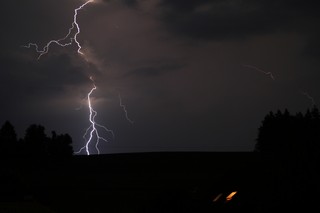 85 mm, f/5.6, 25 s, ISO-100 |
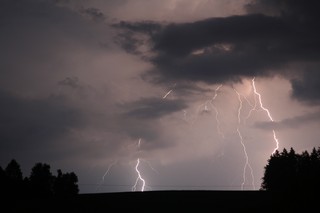 85 mm, f/5.6, 20 s, ISO-100 |
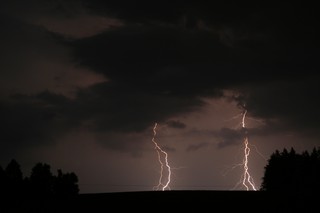 85 mm, f/5.6, 17 s, ISO-100 |
Here are some other pictures taken in September 2006 with the same camera. Here, I couldn't remove the bright windows in the bottom of the image and I didn't want to retouch my images.
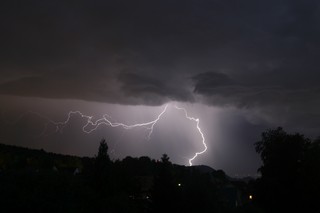 28 mm, f/4.5, 48 s, ISO-100 |
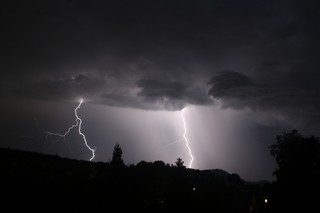 28 mm, f/4.5, 20 s, ISO-100 |
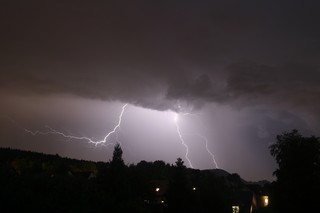 28 mm, f/4.5, 84 s, ISO-100 |
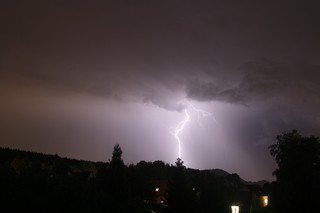 28 mm, f/4.5, 95 s, ISO-100 |
| Home | Optics | Page hits: 022518 | Created: 02.2005 | Last update: 11.2013 |